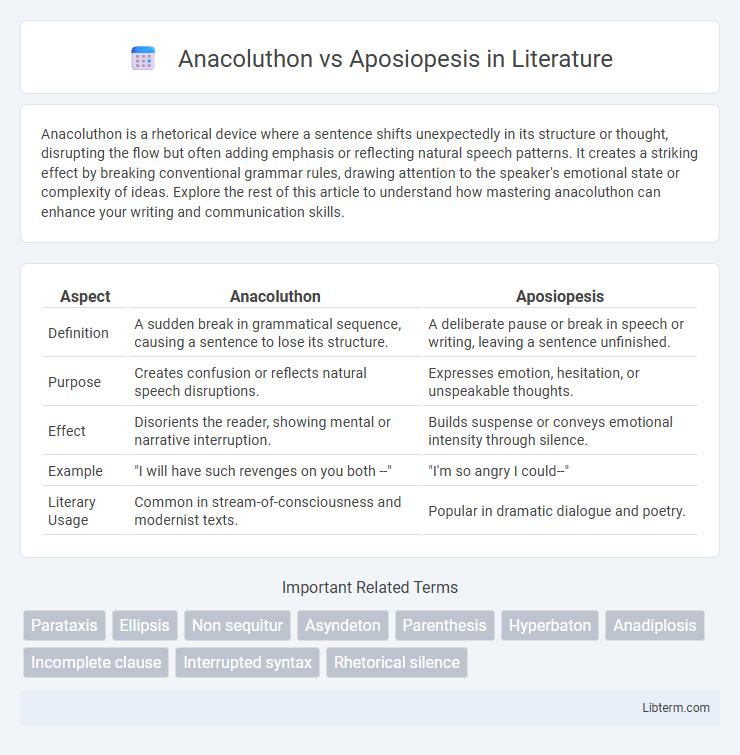Anacoluthon is a rhetorical device where a sentence shifts unexpectedly in its structure or thought, disrupting the flow but often adding emphasis or reflecting natural speech patterns. It creates a striking effect by breaking conventional grammar rules, drawing attention to the speaker's emotional state or complexity of ideas. Explore the rest of this article to understand how mastering anacoluthon can enhance your writing and communication skills.
Table of Comparison
| Aspect | Anacoluthon | Aposiopesis |
|---|---|---|
| Definition | A sudden break in grammatical sequence, causing a sentence to lose its structure. | A deliberate pause or break in speech or writing, leaving a sentence unfinished. |
| Purpose | Creates confusion or reflects natural speech disruptions. | Expresses emotion, hesitation, or unspeakable thoughts. |
| Effect | Disorients the reader, showing mental or narrative interruption. | Builds suspense or conveys emotional intensity through silence. |
| Example | "I will have such revenges on you both --" | "I'm so angry I could--" |
| Literary Usage | Common in stream-of-consciousness and modernist texts. | Popular in dramatic dialogue and poetry. |
Understanding Anacoluthon: Definition and Examples
Anacoluthon is a rhetorical device characterized by a sudden break in the syntactic structure of a sentence, resulting in an unexpected or incomplete thought that disrupts the flow of speech or writing. This device is often used to mimic natural speech patterns, emphasize emotional states, or create dramatic effects, such as in the sentence: "I can't believe you--well, never mind." Examples of anacoluthon highlight its function in portraying confusion, hesitation, or a shift in thought, distinguishing it from aposiopesis, which involves deliberately leaving a sentence unfinished to express emotion or suspense.
What is Aposiopesis? Key Features Explained
Aposiopesis is a rhetorical device where a sentence is deliberately broken off and left unfinished, creating an effect of suspense or emotional overwhelm. Key features include an abrupt halt in speech, the implied continuation of thought, and the evocation of strong emotions such as fear, anger, or excitement. This technique contrasts with anacoluthon, which involves a grammatical disruption or change in sentence structure within a single utterance.
Grammatical Structure: Anacoluthon vs Aposiopesis
Anacoluthon disrupts the expected grammatical sequence by shifting abruptly to a new construction, creating a break in syntax that confounds sentence completion. In contrast, aposiopesis involves deliberately leaving a sentence unfinished, indicated by a pause or ellipsis, to imply hesitation or emotional restraint. Both figures challenge conventional grammatical structure, but anacoluthon reconfigures sentence flow, while aposiopesis suspends it mid-thought.
Historical Origins of Both Rhetorical Devices
Anacoluthon, a rhetorical device marked by a sudden break in grammatical structure, traces its origins to ancient Greek literature, where playwrights used it to convey emotional disruption or confusion. Aposiopesis, characterized by an abrupt pause or unfinished thought, also stems from classical antiquity, notably in Latin and Greek rhetoric, serving to evoke suspense or express overwhelming emotion. Both devices have been extensively analyzed in Aristotle's "Rhetoric," highlighting their significance in persuasive and dramatic speech throughout classical and subsequent literary traditions.
Common Uses in Literature and Speech
Anacoluthon and aposiopesis are rhetorical devices frequently employed in literature and speech to create emphasis and convey emotional intensity. Anacoluthon disrupts sentence structure to reflect a speaker's sudden shift in thought, often found in dialogue to represent confusion or hesitation. Aposiopesis involves abrupt sentence breaks, leaving thoughts incomplete to evoke suspense or emotional overwhelm, commonly used in dramatic monologues and persuasive speeches.
Impact on Reader Interpretation and Tone
Anacoluthon disrupts syntax abruptly, creating a jarring effect that unsettles the reader and conveys a sense of confusion or emotional turmoil. Aposiopesis leaves a sentence deliberately unfinished, inviting readers to fill in the gap, which evokes suspense or intense emotion. Both rhetorical devices impact tone by emphasizing hesitation or emotional overwhelm, but anacoluthon often portrays fragmentation, while aposiopesis implies restraint or unspoken thoughts.
Famous Examples from Classic and Modern Texts
Anacoluthon appears in Shakespeare's "King Lear" when Lear's sentence breaks off abruptly, reflecting his confused mental state. Aposiopesis is famously used in Virgil's "Aeneid," where the speaker falls silent in the face of overwhelming emotion, leaving the sentence incomplete. Modern texts like Samuel Beckett's "Waiting for Godot" also employ anacoluthon to convey fragmented thought, while aposiopesis features in Ernest Hemingway's "Hills Like White Elephants" to suggest unspoken tension.
How to Identify Anacoluthon vs Aposiopesis
Anacoluthon is identified by a sudden break in the grammatical structure within a sentence, resulting in an unexpected shift or incomplete syntax that disrupts the flow of thought. Aposiopesis, on the other hand, is marked by deliberate silence or an unfinished sentence that trails off, often indicated by an ellipsis or dash to show the speaker's inability or unwillingness to continue. Recognizing anacoluthon involves detecting a syntax interruption without completion, whereas spotting aposiopesis requires noting omitted speech that conveys emotion or hesitation.
Effects on Flow and Narrative Style
Anacoluthon disrupts the flow by abruptly breaking sentence structure, creating a sense of confusion or emphasis that mirrors a speaker's spontaneous thought process. Aposiopesis, characterized by intentional trailing off or silence, generates suspense or emotional intensity by leaving statements incomplete. Both devices influence narrative style by injecting unpredictability and emotional depth, but anacoluthon distorts syntactic expectations, whereas aposiopesis evokes reader imagination through omission.
Practical Tips for Using These Devices in Writing
Anacoluthon and aposiopesis serve distinct rhetorical purposes: anacoluthon disrupts expected syntax to mirror natural thought or confusion, while aposiopesis intentionally breaks off, creating suspense or emotional emphasis. When using anacoluthon, maintain clarity by ensuring the disruption enhances the narrative voice rather than confusing readers; aposiopesis works best when the trailing off suggests unspoken emotion or leaves interpretation open. Writers should employ anacoluthon sparingly to avoid disjointed prose and use aposiopesis strategically to evoke reader engagement and dramatic tension.
Anacoluthon Infographic

 libterm.com
libterm.com